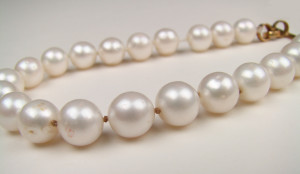 One of the issues confronted by all professional pearl and bead stringers is that most thread, including silk, stretches. Despite our best efforts and the best efforts of manufacturers, over time, the stretching results in gaps between beads and pearls, not, obviously, an attractive look. (Recognition of this normally occurring stretching is the reason GIA recommends pearl necklaces be restrung every six months and is clear in the dirty and stretched thread of the pearl necklace pictured above.)
One of the issues confronted by all professional pearl and bead stringers is that most thread, including silk, stretches. Despite our best efforts and the best efforts of manufacturers, over time, the stretching results in gaps between beads and pearls, not, obviously, an attractive look. (Recognition of this normally occurring stretching is the reason GIA recommends pearl necklaces be restrung every six months and is clear in the dirty and stretched thread of the pearl necklace pictured above.)
I’ve developed a DVD, a bonus that accompanies Vol. I and Vol. II of the Professional Pearl and Bead Stringing course, that details my own approach to the issue. However, I recently saw these tips, one of which makes a lot of sense, and one of which doesn’t.
Both tips were reported in the February, 2015 edition of MJSA Journal in an article called “Stretch it Out.”
- Kimberly Ingersoll in Viola, Wisconsin, wrote in to suggest that pearl and bead stringers immerse the silk thread in water and then hang it with a weight to dry. She suggests using fishermen lead weights. An alternative might be a hammer. I haven’t tried this technique – frankly, it was new to me. My only concern is potential damage to the thread in the same way that water can damage silk clothing. I may be wrong, though, and this definitely sounds worth trying.
- Another reader, a Judy Willingham from Manhattan, Kansas, suggests attaching the clasp and dipping the exposed silk in ordinary rubbing alcohol to wet the string. Then she shifts the pearls back toward the clasp and suspends the whole thing to let the silk dry. Willingham claims this straightens the silk and stretches it a little before knotting.
I would strongly recommend against this method. In fact, I’m a little surprised MJSA Journal printed it without a discussion. I wouldn’t knowingly expose pearls to rubbing alcohol any more than I’d knowingly expose them to acetone or perfume. The risk of nacre damage is too great.
However, the first recommendation makes sense. If you try it, let me know. I’d be interested in your results.

